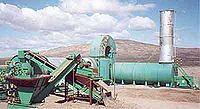Difference between revisions of "Refractory Lined Dryers"
Jump to navigation
Jump to search
(Created page with "Category:Drying{{Knoppen}} <noinclude><!------------------------------------------------ * READ THIS FIRST * Only edit this page if you can improve the content. * Imprope...") |
PurplePen19 (talk | contribs) |
||
| Line 5: | Line 5: | ||
* Please start editing this page after the /noinclude | * Please start editing this page after the /noinclude | ||
* -------------------------------------------------></noinclude> | * -------------------------------------------------></noinclude> | ||
This | [[File:Refractory Lined Dryers.jpg|thumb|200px|right|Refractory Lined Dryers]] | ||
'''Refractory Lined Dryers''' are designed to withstand much higher temperatures than [[Rotary Dryers]]. Typically, if you are dealing with a direct fired rotary [[Kiln]], it is refractory lined with a brick or castable lining. This lining protects the steel shell. Rotary dryers are typically not lined, and their steel is not able to withstand such high temperatures. If you are dealing with an indirect rotary kiln, the kiln is not normally lined, so the shell of the drum has to be made out of a temperature resistant alloy instead of steel. | |||
Revision as of 01:07, 19 August 2012
Refractory Lined Dryers are designed to withstand much higher temperatures than Rotary Dryers. Typically, if you are dealing with a direct fired rotary Kiln, it is refractory lined with a brick or castable lining. This lining protects the steel shell. Rotary dryers are typically not lined, and their steel is not able to withstand such high temperatures. If you are dealing with an indirect rotary kiln, the kiln is not normally lined, so the shell of the drum has to be made out of a temperature resistant alloy instead of steel.
